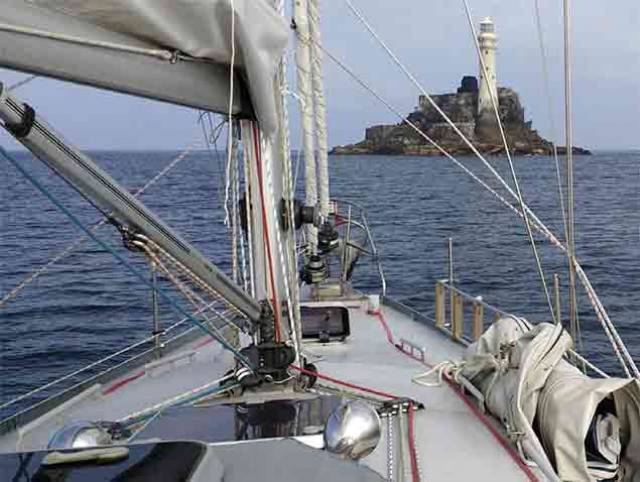Cruising sailors Fergus and Katherine Quinlan were presented with an international sailing award by the Ocean Cruising Club in April in recognition of their voyage from Galway Bay to Russia and back in one season. The couple sailed Pylades, a 12m van de Stadt-designed cutter, built in steel by Fergus and Katherine at their home at Kinvara on the west coast of Ireland. The voyage was approximately 3800 miles and was of 109 days duration, beginning this time two years ago.
 Fergus and Kay Quinlan pictured at the OCC awards in April on board the SS Great Brittan in Bristol with the David Wallis Trophy for their winning log of a voyage from Ireland to Russia and back in 2016
Fergus and Kay Quinlan pictured at the OCC awards in April on board the SS Great Brittan in Bristol with the David Wallis Trophy for their winning log of a voyage from Ireland to Russia and back in 2016
Saturday 14th May 2016: Katherine and I slip Pylades off its mooring at midday and motored west from Kinvara. The sea was quite in the bay, a limpid calmness which extended out beyond the shelter of the Aran Islands. Dolphins accompanied Pylades south, where one pod left off another joined, in the translucent seas they were clearly having fun under a blue sky as they bellied up beneath the bows in a high-speed sex romp. The Blasket Sound and its restless water has many faces but on our first morning underway it was shrouded in a slow fog. Its islands and their outliers were but ghostly images imparting an air of deep melancholy. By contrast the Dursey Sound, a few hours later, was a blaze of bright sunshine with figures who waved us through from both shores.
The Fastnet Rock emerged from a flat ocean in whispers of wind. Reflecting on a previous storm, we motor on our way. The calm allowed the easy sighting of many whales and myriads of dolphins. A waypoint was set for the Seven Stones Light Vessel; it was a cold night on our 3 hour watches. The plotter showing our position and Automatic Identification System [AIS] that of other vessels was, for us, a new experience. We noticed some of the AIS screen images becoming static, an object query revealed that their transmissions were old and thus, we had discovered ‘ghost ships’.
Adding to the nights’ interest, the galley sink refused to drain, grease was the likely culprit. Hot water and chemicals did not sort the problem. Neither did poking with wire. Presses were emptied, the seacock closed and the pipework dismantled, while removing the final connection the bronze flange of the seacock sheared off. Gingerly opening the seacock there was only the tiniest trickle, the skipper plunged a screw driver down the open valve, resulting in the ejection of an impressive lump of grease followed by a 38mm diameter column of solid Atlantic, thankfully the seacock closed to await a new fitting.
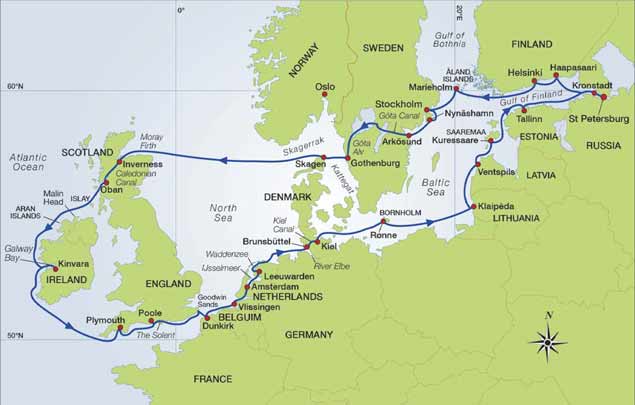
17th May; 06.20 abeam Lizard Point and dodging real ships. Entering Plymouth Harbour, we crossed the ‘bridge’ and anchored in the pool west of Drakes Island. Next morning, Pylades moved to the sixty euro a night, Queen Anne Battery Marina. In the adjacent Marine Bazaar, a tail for the sink outlet seacock was located and full flow restored. 13.00, we exit, bound west. ‘Passage Weather’ forecast wind F2 to 3 fair, the met office coastal F4-5 occasionally 6, with rain. The latter was correct, a rotten night at sea, compounded by ghost ships and AIS images approaching at 33 knots, which subsequently materialised as Motor Torpedo Boats. Later the skipper misjudged a trawler and was forced to jibe. Nevertheless, with wind aplenty great progress was made under a double reefed main and half a headsail.
20th May; Portland Bill Light 6 miles to port appeared through a clearing mist, as did the moon, reefs are released. Diverting to Poole Harbour we recollect the near miss of Hilaire Belloc’s yacht Jersey at the adjacent Anvil Point, a mathematical error by Katherine and Pylades almost followed suit – reduced wine rations. At 10.30 we picked a free mooring. Over the next two days we sheltered, work on boat bits, sip wine and watched the passing parade. Diversion came at night with a wind blowing against the strange tides of Poole, we became tide rode overriding the mooring buoy which dragged itself back and forth under the bow with alarming noises. A restless sleep occasionally altering the chaff points on the lines.
22nd May; with tidal gates calculated we sailed for the Needles, the west entrance to the Solent. The Cardinal buoy approached with an alarming bow wave, we passed within a hair’s breadth. Choppy swirling currents carried Pylades to the home of English ‘yachting’, the Solent filled with boats of all descriptions, we saw more boats in the next hours than in the previous ten years. Following in the path of the Howth Gun Runners we put in to Cowes.
A pleasant place, not overtly expensive. While Katherine did not search for a yachting cap as did Mary Spring Rice in July of 1914, we went in search of the Royal Marine Hotel where the crew of Asgard supped as they waited the arrival of the Kelpie. We were miss-informed that the hotel was now the clubhouse of the Royal London Yacht Club. Following consultation with the club records, we were introduced to Mr John Power of whiskey making fame. He was a repository of knowledge regarding the events surrounding the Asgard. To an expanding circle in the club we explained our quest regarding the relative benefits to the Irish people of the 1916 rising and the 1917 Bolshevik revolution. A club member exclaimed it was the most interesting discussion in the club for many a year. We were invited to give a talk on our return, however we explained that our route home was to be via Scotland. Our idea for a drink in the Royal Marine Hotel did not materialise, it had been demolished. As promised, a copy of the skipper’s book ‘The Republic of Reason & The Poverty Philosophy’ was delivered, not sure what The Royal London YC made of that!
23rd May; We took on fuel and reluctantly exited Cowes at 12.00, weaving our way through the showrooms of vessels and the familiar references gleaned from too many years reading – Practical Boat Owner and Yachting Monthly we left the sheltered waters of the Solent. Out of the blue the roar of a low flying fighter, a Spitfire, displayed its unmistakable profile, it banked at mast height around Pylades linking us back to wars and guns. Its electrifying scream brought back boyhood memories of the passionate desire to fly that ultimate air machine.
24th May; 05.00 passing Dungeness Point nuclear power station, a light wind built on the nose, we motored on and tied at a very quiet Dover Marina. Anne Korff from Kinvara arrived for a nostalgic passage to her origins, Germany. We took the aft fitting off the boom to free a jammed reef, top up the tanks and ensured all was well for the channel crossing. Next morning exiting with perfect timing we catch a favourable tide, likewise, with perfect timing the plotter screen went black, it left dozens of moving AIS images but showed neither the chart nor Pylades position. Improvisation was in order, Katherine repeatedly transferred our position from the GPS to the plotter, at least we knew which ship was going to run us down. The procedure kept us busy and worked, considering the amount of information those on board the Asgard and Kelpie had at their disposal in 1914, we could not complain.
From a position south east of the Goodwin sands Pylades proceeded on the requisite 90 degree crossing of the lanes. A few nervous hours in poor visibility dodging ships approaching from the northeast and then the southwest. At the same time the favourable flood tide swept us sideways down on the Ruytingen SW Buoy. This we assumed was the station of the Ruytingen lightship in 1914, the rendezvous for the yachts Asgard, Kelpie and the German Tug Gladiator out of Hamburg. Through the fog of time and history we imagined the racing hearts of the young men and women aboard those yachts on that 12th July as 1500 guns and heavy ammunition boxes were transferred. How could they foretell what glory, what blood, what disaster, these instruments of death would bring? Reflecting on these rich moments of history we were swept in to the deserted Dunkerque marina at 18.45.
26th May; it appears we cannot escape from the shadows of war! Heavy black smoke poured across the town and beaches of Dunkerque, another Spitfire screamed overhead. Vintage warships filled the bay, hundreds of soldiers in WW2 fatigues swarmed in the surf. Film making was underway, it was the 76th anniversary of the Dunkerque evacuation when 338,000 English, French and Belgian soldiers were snatched by a medley of boats, including yachts, from the approaching fascist army. Reflecting on the divisions of nationalism and competitive greed, forces which still destroy countries and people, the skipper works on the reef block which had jammed yet again.
27th May; through a light fog and past the dissipating warships we pushed along the coast to Ostend where we were greeted by the marina manager Patrick and his dog Shifty who promptly bit the skipper, no blood was drawn but might have been if he had one of the Mausers from the Asgard. An easterly wind hardens and keeps us in Ostend on walkabouts and doing odd jobs for four days.
1st June; 06.00 leaving Ostend harbour entrance a fishing boat trailing side nets lunged at us out of the fog, we spun Pylades on its length and headed out to sea. It was a stressful passage, particularly without the AIS, we were constantly transiting between the cockpit and the radar. The alternator failed, the radar was now draining the batteries, thankfully the fog had dissipated by the time we arrived in the Netherlands and tied at Breskins Marina. After much testing and fiddling we sought professional assistance. An electrical wizard wired in a bigger bulb at the control panel and explained in detail why this would solve the problem, the skipper now short €268 pretended he fully understood. In the meantime, Katherine was working her way through every facet of the computer to restore AIS and the Open CPN charts, to no avail. Northeast winds were forecast to blow firmly for the next week which would greatly impede progress towards the Frisian Islands. The marina manager suggested we travel inland north through the Netherlands. Brilliant, we concurred and bought a copy of the ‘Staande Mastroute’ an astonishing amount of information for €20.
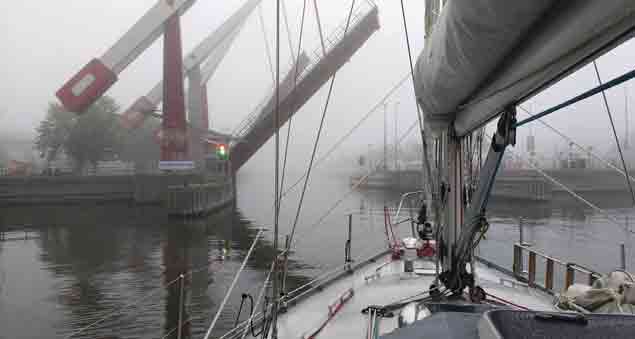 Ghostly Bridges in the Netherlands
Ghostly Bridges in the Netherlands
3rd June, fog and ripping tides herald our arrival through the lock gates at Vlissingen into the calm and amazing canal system of the Netherlands. Motoring through swirling fog; ghostly traffic lights flashed their signals to proceed or pause as spectral bridges swing or lift before us. The infrastructure for the passage of Pylades is a feast of beautiful engineering and is provided as a vast state funded service. That evening we anchored in a pool off the ‘Jachtsluis’. We sipped wine, the cuckoo’s call echoed along the waterways while thunder rumbled in the distance, it was an excerpt from Beethoven’s 6th, the Pastoral Symphony.
5th June, commencing at 05.30 the day was travelled at 5 knots, looking into a thousand back gardens, gliding over motorways, steering our ship level with house roofs, bridges tilting and turning and children jumping into the canal. In the village of Woubrugge we paid €13.00 and rest. Next morning, we shift at 05.00, it was cold under a clear blue sky. After two further days of canal gliding, we arrived at the outskirts of Amsterdam. Heavy rail and road city traffic dictated a night passage. At midnight, bells clang, lights started to flash, we and one other yacht were ready, huge bridges, two rail and two motorways opened, the lights went green and a loud voice from the dark shouts Go! Go! We slammed the throttle to the floor, Pylades achieved a standing start from zero to 7 knots in seconds.
A minute later the bridges closed and trains and trucks resumed their voyages, our hearts were pounding. Over the next few hours we passed 12 bridges and two sluices, during which a man on a high-Nelly bike with coat tails flapping shouts encouragement as he whizzes past. It was he who opened each bridge as we passed.
Suddenly, white lights and a bow wave filled the canal from wall to wall, two full size commercial barges one pushing the other bore down, panic, the yacht in front slowed, if we followed suit Pylades would lose steerage and be sucked into the barge path. We throttled up, passed the yacht at speed and charged, steel barge-walls slid by a fender width to port. Exiting into the Amstel river at 03.00 we were shattered and bewildered by lights and ships. Thankfully the accompanying yacht suggested that we go back into the canal and tie for the night, this we gratefully did and fell into a fitful sleep.
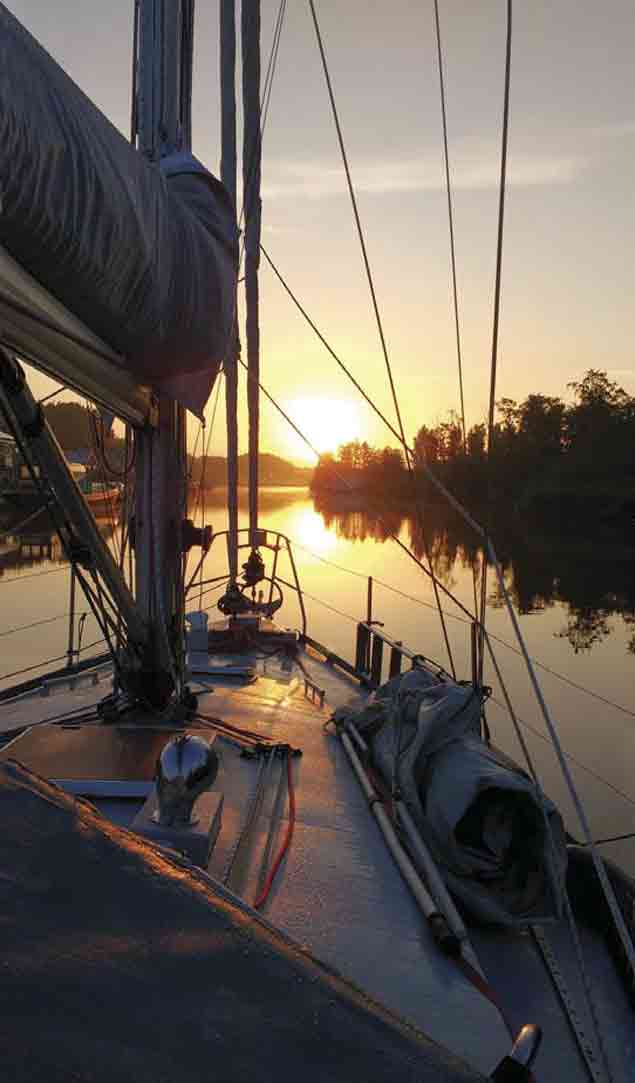 Dawn near the Ijsselmeer
Dawn near the Ijsselmeer
7th June, Anne Korff left to fly home, we crossed to Amsterdam marina for fuel. By 14.00 we were sailing close hauled across the Markermeer. After a choppy approach into Lelystad, we celebrated our progress with a bottle of bubbly. Head winds on the shoal waters of Ijsselmeer forced the use of full mainsail and engine to batter our way to the calm waters of Lemmer in Friesland. Next day we ground twice as we passed a growing concentration of locks and bridges and had further close encounters with commercial barges.
Entering the pretty town of Leeuwarden, a lock-keeper swung a clog on a fishing line to collect a €7.00 toll. For the service we were getting, one could hardly complain, unfortunately in the rush a sterling coin ended up among the Euros. For this crime we were blocked at the next lock by the only keeper in Holland who couldn’t speak English. We grounded the boat into the canal bank to have an animated discussion, passers-by joined in to translate and placate, the people were astonishingly friendly and helpful. Pylades was waved through and we tied to the canal bank further on. Here we watched an air display and observed a jet-fighter stalling, it didn’t recover. Thankfully the pilot had ejected and landed with cuts, bruises and a few broken bones in a glass house, the jet hit another glasshouse and destroyed its tomato crop.
10th June; on the approaches to the Lauwersmeer in centre of a well-marked channel we ran hard aground. No amount of engine would get us off, we opened the full Genoa but the wind was insufficient to help. Just when we needed a big motorboat, there are none about. Two yachts eventually approached, from the north a traditional lee boarder and one from the south. They combined forces with our engine and got us off. Their shouted instructions were to stay close to the red marks away from the centre channel, every day we got a little more confused. In Yachthaven Lauwersmeer, the chilled bottle in our fridge exploded, we went for pints in the bar. Here we met the only Irish flagged boat of our journey, a Drascombe lugger on its way to sail in the wake of Dulcibella, the featured yacht in ‘The Riddle of the Sands’. A book written by the same Erskine Childers, who’s real life adventures in running rifles from the Ruytingen Lightship back to Howth, we were following.
The next day we passed the final lock and into the Waddenzee. Adjusting to a more solitary life Pylades pushed northwest between the Friesian islands of Ameland and Schiermonnikoog. We grew apprehensive, one of the buoyed routes shown on our chart had disappeared, another, the one we were following headed out into the North Sea and did not correspond with what we had. Proceeding further our soundings decreased and higher grew the sea. Many miles out from the shore where we could barely see the islands were sandbanks and breaking seas. Just when despair was about to consume us, the soundings went from 3 to a more tolerable 10 meters. For a crew used to the generous depths of the west coast, the experience was to say the least, stressful.
An easterly wind and tidal calculations decided that we should return to shoal water and land at the German Island of Borkum, again the entrance channel was surrounded by ribbons of banks with erratically breaking seas, it was indeed, a riddle of the sands. We were trying to imagine the difficulties without GPS, to get accurate bearings on the low islands would have been, tricky. An ill designed pilot launch passed very close at speed and buried us in its wash, one of its crew ran to its stern waving an apology. In the still harbour of Borkum we lay alongside a friendly German yacht.
12th June; a bus ride into a fairly dull holiday resort town, a German version of Butlin’s Holiday Camp. Noon next day we headed for deep water. With the wind on the nose we motor tack and battered our way 80 miles overnight to the river Elbe and Brunsbùttel. During the darkest hours, we saw a bank of lights stretching miles across our track, it was an anchor field. Like an ant amongst the elephants we threaded our way through 18 anchored light festooned vessels. 03.00 on this wet grey morning we left the German Bight and were sucked by the tide into the Elbe, sticking to the starboard edge of the channel a chain of grey ships with frothing bows overtake on their way to Hamburg. We found a gap in the procession and gunning the engine, skidded across the river to the gates of the Kiel Canal.
By 09.00 we were in the first lock with a ship and a scattering of small boats which had materialised out of the rain. This 60-mile short cut into the Baltic was built primarily to facilitate German Naval power prior to the First World War, it is so wide and straight that much of the passage could be on auto-pilot. Halfway along the canal we tied to the rain soaked marina at Rendsburg, an interesting medieval town.
15th June; 12.30 transiting the final lock, we entered the Baltic, canal fees, to our delight had been abolished. The marina at Kiel was fairly full, but after much manoeuvring we found a slot for €20 per night. Walking the city, thundering rain forced us into a shopping mall and hunger forced burgers and chips. A €10 taxi with busy wipers got us back to the Pylades wine bar. The morning brought fair weather, hiring a pair of high bikes we whizzed along the myriad of cycle lanes in a city where bicycles and pedestrians seem to have priority. Our new transport system shuffled, oil, laundry, shopping and finally a new chemical toilet for the confined waters of the Baltic and canals. The toilet on Katherine’s bike combined with a tricky back-peddle brake saw her crashing, thankfully without damage to either to rider or goods.
17th June; Kiel Week, the biggest sailing festival in the world with 2000 boats partaking in all sorts of events commences. To make space, we exit for the bleak and shallow marina at Wendtorf. Next morning found us underway to the island of Bornholm, Denmark. A securite call from German warship Rothwild warned of an underwater explosion at 12.45. the position given was about seven miles off, the warning was repeated every fifteen minutes and a final countdown over channel 16 in which the whole bridge of the warship participated. A few seconds after the zero there was a mighty dull double thump followed by an eerie silence. The skipper will regret for life, not calling and ascertaining that all was well on the warship, wishing them well and to enjoy the large fish supper. The wind was westerly and picking, under two reefs and some Genoa, cheered by a red sunset and under a full moon we fly along. Ships lights slid by in all directions. The next morning with more luck than ability the skipper cracked the electronic glitch, the AIS, GPS and the electronic charts were finally brought back together, bliss.
19th June; the following sea grew boisterous and the water shoal as we approached Ronne harbour in Bornholm. Calling the harbour for advice they said “you will probably be OK”. Apprehension peaked when there was no entrance green buoy as shown on the chart. As we rounded into the harbour the layout had changed from the chart, we tie and spend a day shopping, walking and fixing the staysail.
21st June; Mid-summer, was cold and the rain poured, but hope springs eternal, the barometer was 1011 and rising. Behind schedule, we skipped Poland and headed to Lithuania, with one reef in the main and a poled-out Genoa we ran east. An urgent call on the VHF stated that we had entered a prohibited area, a large tug escorted us away, it was only a minor course deviation. Air pollution in the Baltic on a clear day showed a brown mist on all horizons and at night only the glow of the main stars penetrated, of the milky way there was no trace. At dawn on the 23rd we entered the extensive harbour of Klaipeda, found a deserted yacht harbour and slept. A few hours later a gentle knocking and a kind face asked to move to Castle Harbour, “not a bother” we replied. Passing through an intriguing hand operated swing bridge we tied at a picturesque marina. The harbour master said they ‘maybe’ never had an Irish boat, he unfurled an Irish flag, we thanked him, even if it looks Italian.
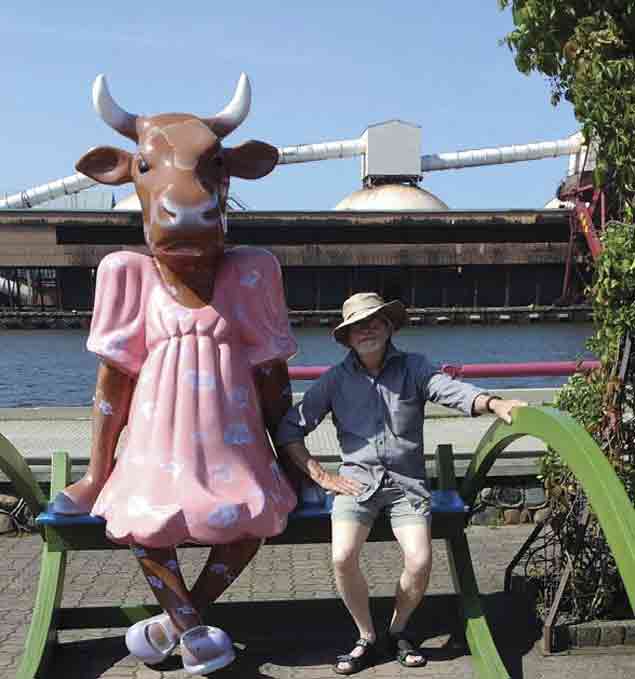 Good company in Latvia
Good company in Latvia
24th June; A warm day spent walking the attractive town and sipping coffee in sidewalk cafes, people watching. Observing the almost complete absence of advertising and women wearing high heels, we developed an opinion, imagined or otherwise, that in the former countries of the USSR women walked as though they were about to go on stage, was it all that socialist gym and ballet? The next day calm and under a blue sky we pushed north. To starboard an interminal ribbon of sand that comprised the coasts of Lithuania and Latvia backed by a pine forest, its perfume washed over us. At 21.00 the idle offshore breeze got bored and dumped a squall with 35knots of wind, thunder and lightning on us, the sea built and died quickly.
26th June; 07.00 arrived Ventspils in Latvia and tied bow on with stern buoy. The only boat in the marina we received a warm welcome. We visited the Castle of the Livonian Order, basically they were an armed gang from 1230’s involved in various power grabs while enforcing the dominant superstitions of the era as a cover. Next morning went for a plunge off the nudist beach, the grey morning did not invite a long stay. Exited at 18.00 into a fine night with a light westerly a few ‘cities of light’ liners passed on their way to and from Riga. In the calm morning, we entered the three-mile approach to Kuressaare on the island of Saaremaa, Estonia. Narrow and only 2.7 meters deep with birds standing on shingle beaches at both sides of the boat. We were the second Irish boat in 12 years, in our honour, the tricolour was hoisted on the marina’s yardarm. There were 132 spaces in the marina with six boats.
 Hells Angel
Hells Angel
Hiring a 49cc scooter with helmets, we both squeezed on to the tiny bike and roared off into town. Katherine shouted from aft to keep the speed down, the skipper retorted that we were doing just over 20 mph and were at full power. We got a camping gaz cylinder filled €5.00, go shopping, do the sights and rode into town for beers, our nightmare would be a line of 1000cc ‘angel’ bikes in front of the pub, thankfully there were none, our image and self-esteem are maintained! Next morn after a swim in murky tepid water, Katherine attempted wheelies on the scooter and we hand it back.
30th June; at dawn, we pushed north through the shoal channels between Hiiumaa and Vormsi and out into the Gulf of Finland, only two yachts sighted. Next day we entered the guest harbour of Pirita, built for the Moscow Olympics of 1980, now ‘down at heel’. The bus took about 15 minutes to the medieval city of Tallinn, fascinating with winding narrow streets and myriads of little bars and restaurants. An evening of splendid wine, food and ambiance in ‘Franks Bar’. Next day more exploration soaking up its history and architecture, we examined a spacious church which having been used as a centre for dance during the socialist period was gloomily being restored for worship.
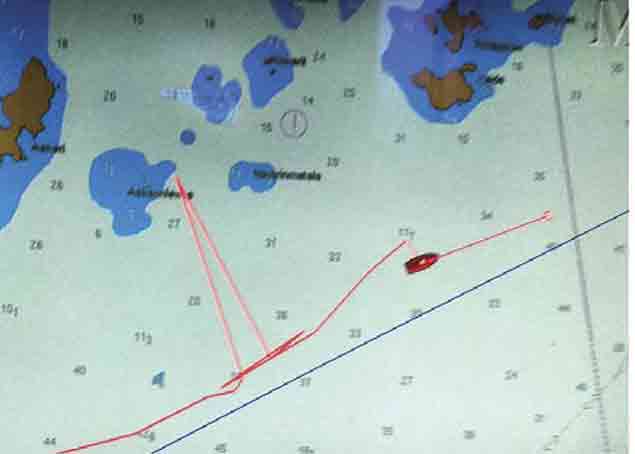 Who is messing with GPS?
Who is messing with GPS?
3rd July 03.00 a red thundery dawn with a light wind astern, the barometer was falling, there were warning of gales as we crossed the Gulf of Finland bound for Haapasaari, Finland. Some ships were transiting the gulf, but no other yachts were sighted. Closing the Russian border, the GPS position of Pylades went wild, jumping a mile back west, then east, then north, it took about 15minutes to settle down. In the meantime, the skipper was transferring ‘old type’ compass fixes on to a chart. With binoculars, we picked out the leading channel buoys. Later asking the Finnish Border Guard, who might be responsible, “impossible to know” is the answer, the Russians, the Americans or NATO. We entered the tiny landlocked harbour and tied at a timber pier, unfortunately on top of a rock, where, in a rising gale we bumped through the night. Next morning at the diesel dock, Sonia the all-round shopkeeper, dock and diesel master, switched on the pump whilst instructing that if the dock pump did not work, “tickle it with your finger, my pump I think she is a woman”. As the rain lashed and the wind howled we fill with diesel and wandered the beautiful island. Costs were €10.00 per night.
An islander knocked on the boat and invited us to the community centre where an exhibition of historical photographs was on display, then to his house to meet his father. We learned about Haapasaari and its history. There are 70 houses on the island, during the winter only about 10 are occupied. Each house has a flagpole, when occupied they hoist a long tail version of the national flag, to inform all that help or company is available. This custom seems to prevail throughout Finland and Sweden. He warned us that the island has ticks some of which carry a risk of infection and advised against walking on the grass barefoot, adding that his brother was infected resulting in brain damage. We think they need a St. Patrick here to go banishing!
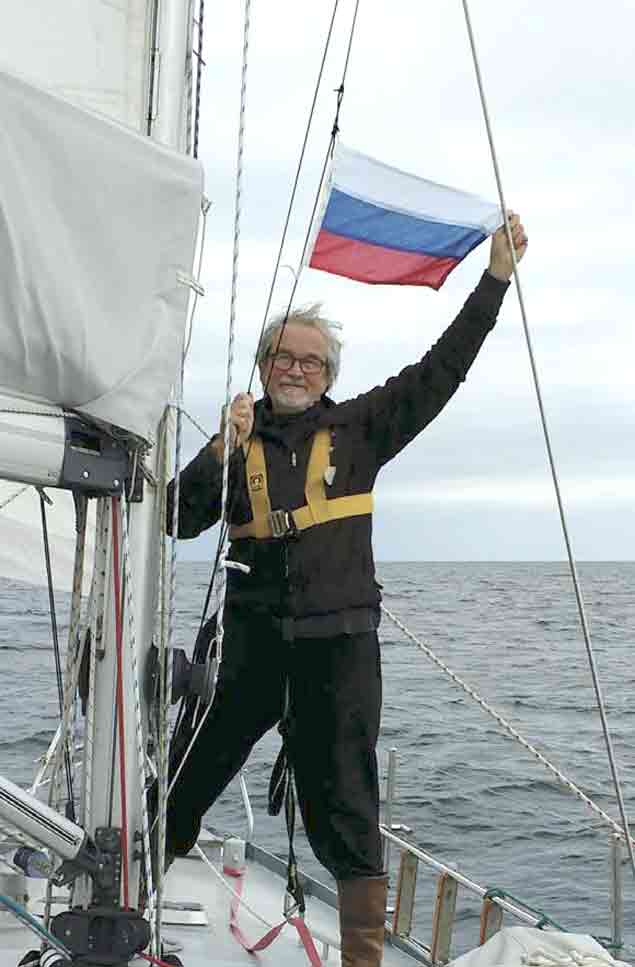 Entering Russian Waters
Entering Russian Waters
6th July; the gales ease, barometer 995 and rising, we checked out with the Finnish border guard and at 13.30 set course for Russia. At 15.35 crossing the border, we contacted the Russian Coast Guard, a deep gravelly voice bade us proceed. Hours later they call, “yacht Pylades, confirm that you are eight cables south of Somers Island”, we respond, correct that is our position; “proceed”. By 03.00 the following morning the westerly wind and sea had increase. While the marked shipping lane is dredged to accommodate cruise liners the approach to the Kronstadt had the feel of shoal water. During the final mile, the waves became very confused bouncing back from the fort walls, we hand steered. Through the entrance the lights were blinding, we approached the dock a woman in a soviet looking uniform booms “tie here”. The skipper leapt ashore and shook hands, she almost smiled and instructed regarding passports and
A thin uniform with a mustache arrived, he searched the ship and pulled out all our wine bottles. We believed that wine would be exorbitant in Sweden and Finland and loaded in Germany for the voyage. He photographed the hoard and left. Customs arrived and explained that we were only allowed four bottles each, much rancour and debate followed, but they had superior firepower so we lost about 45 bottles. The whole procedure had taken six hours, with resolute stoicism we re-hoisted sail and scudded east before the rain and wind.
On our final approach the thudding beat of Shostakovich’s 7th ‘The Leningrad symphony’ fills the cockpit. It had been first performed when the city was under siege by the German and Finnish armies, the most lethal siege in history, over 900-days one and a half million people died from bombardment and starvation. Hitler commanded that it be erased. The musicians who played at that heroic première were starving, three had died during rehearsals. To silence German forces, a Soviet military offensive, was launched just prior to the performance which was broadcast live to the city and German lines by loudspeakers. This première was considered by music critics to be one of the most important artistic performances of the war, its psychological and political effects triumphed over the soulless Nazi war machine. The concert prompted an hour-long ovation, one that still echoes.
High speed hydrofoil ferries darted past in all directions concentrated the mind, we kept our cool and maintained slow, steady, progress along the starboard edge of the channel. We then lost our cool when we saw a bridge under construction across our course to the marina, it was not shown on our chart. We steered for the unfinished gap; (later we were informed that our air draft of 15meters would not have been a problem anywhere under the bridge). The buoyage at the other side was missing so we gingerly sounded our way into the Central Yacht Club Marina. There, to our delight, through the rain, we saw the unmistakable Vladimir Ivankiv, waving. After handshakes and hugs we realised that we had reached the Russian Federation and the end of our journey east.
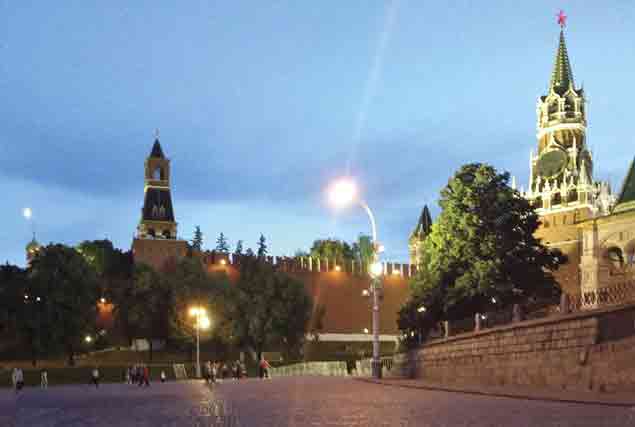 A rising moon in Red Square
A rising moon in Red Square
8th July; In need of exercise, we walked to the centre of Petersburg, the city slowly opened before us with all its waterways and magnificent architecture, even if somewhat gaudy to west European eyes. Soaking ourselves in its ambiance, we had a delightful lunch in town and travelled back to base on the amazing metro. One never had to wait for a train, it was always there or just coming. The grip of the new oligarch culture is apparent. The copious collective ‘propaganda’ posters pushing for gender equality, race equality and international solidarity of the soviet years, have been replaced with ‘advertising’ for personal consumer goods, motor cars and white teeth.
 At the Kremlin
At the Kremlin
After another day exploring the city, we caught a train to Moscow on Sunday morning, traveling at up to 150 miles per hour, the Sapsan Express covered the 400 miles in under four hours. At €75 per night for two including breakfast, the hotel was excellent, how large the bed seemed after our boat bunk? The rest of the day was devoted to sightseeing. The scale of the city is vast, its people overtly friendly. The written language is extremely difficult to decipher, such as when we were trying to match a street name to a map, however when we did produced a map, people inevitable approached and would go out of their way to help and explai
And we danced by the light of the moon When Katherine was a young girl, she dreamed that one day she would dance in Red Square. That evening at Kremlin’s wall, we danced by the light of the moon.
13th July; we met with representatives of the Moscow Museum of Architecture as part of our quest to bring an exhibition of VKhuTEMAS to Ireland, but that is another story, click on the following….. Bolshevik Avant-garde
Our return to Pylades was via the romantic overnight sleeper train, all booked by Vladimir, our amazing OCC port officer. We wandered Petersburg again, unfortunately two places on our visiting list, the battleship Aurora had been removed and the Museum on Siege of Leningrad was shut and looking neglected. (The Aurora has been refurbished and is now back on station).
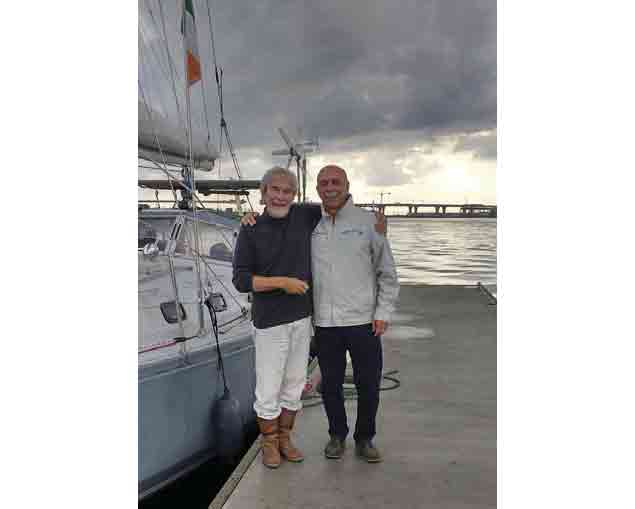 Farewell to Vladimir Ivanikov
Farewell to Vladimir Ivanikov
Time to leave, bidding farewell to Vladimir we presented him with the skipper’s book, took some photos and headed for the Kronstadt. We checked out without incident although the customs officer looked distinctly sheepish. Outside, the westerly wind was throwing up a nasty sea, progress was slow and the engine, being in high gear was complaining bitterly. We had to run off downwind to change the pitch of the Gori propeller, turning up with higher revolutions, we hoisted the mainsail and for six hours battered our way west. At 17.00 the wind had eased and we reset the propeller pitch, eventually the wind died completely and the sea went silky smooth. Crossing from Russian to Finnish waters washed with the light of a spectacular sunrise, Sibelius’s ‘Finlandia’ filled the air.
15th July; 04.00 tied at the Custom dock in Haapasaari and slept for five hours. By 09.45 were cleared and on our way. The wind was east 20 to 30 knots giving exhilarating sailing through the archipelago, due to their twisting nature most of the passages required hand steering and this was to hold true until departing Sweden. Pylades is set up with its plotter at the navigation table, waypoints being transferred to a simple above deck pointer, no problem for long distance, but the more common arrangement of an aft wheel and instruments would be handier in these waters. Our arrival in Lovisa was entertaining for the crowds gathered for the traditional boat festival. In the fresh breeze the skippers boat handling went pear-shaped, but an able seaman boarded to bring us to a different berth, we ran aground. Eventually we got off, got in, tied and settled. The town was pleasant, immaculately clean, built on a strict grid pattern. We visited the cathedral; the caretaker described its history explaining that the town has 8000 inhabitants and this church had services every day and two on Sunday. Now they have just one on Sunday with about 25 to 30 people in attendance. The building is extensively used for music recitals.
17th July; strong wind warnings persist in the gulf but we got used to its complexities and its swell free sheltered waters. It was cold and grey as we sailed west, by 16.00 we were in Helsinki, the marina was €25.00 a night, excellent showers and in the centre of a magnificent city, we loved it. For two days we luxuriated in the reflected ambiance of one of the world’s most egalitarian and advanced societies. We sat at a sidewalk bar and shared an excellent bottle of cava for €15.00, counted our blessings and deliberated on how one might develop such a society back home.
 Anchoring in Finland
Anchoring in Finland
19th July; a calm summers day motoring until 17.00 we anchored off the fairway near Barósund. an idyllic location. The following morning at 05.30 we were under way, the water a mirror giving a perfect double take on this land of a thousand islands. In the city of Hanko, we caught up on our laundry and fixed the persistent leak in the pumped water system by replacing the accumulator tank with a new length of pipe. In this sociable harbour, Pylades being steel and grey with wind vane self-steering and solar panels, sparked discussions on boats and sailing grounds. More than a few expressed reservations about sailing in the tides and swell off the Atlantic seaboard, perhaps they had a point!
22nd July; 05.30 tricky exit as we were boxed in with stern lines, but get away without disturbing the natives. On these early mornings we seldom met other boats in the channels, by 10.00 Finnish and Swedish flotillas were passing in all directions until about 17.00 when all quietens. Later in the day we entered the archipelago of Äland, anchoring near Kökar. We have never used the engine as much but with calms, contrary winds and twisting channels one had little choice. On the afternoon of the 23rd July we tied at Marieholm, capital of the Äland Islands, a port busy with cruise liners, ferries and the last of their splendid old sail trading ships. We walked the woods to town and slept well. A troop of Irish scouts cruising on a tall ship paid us a visit, it was refreshing to see such a fine bunch of boys and girls.
25th July; the wind vane came out of hibernation, even though the passage to Sweden had only 25 miles of open water. There were ferries and even a few boats on passage, we anchored off Söederfladen and changed courtesy flag and timepieces. Next morn, we were away at 04.30 inhaling the wonderful pine fresh air of Sweden, by 13.00 everywhere one looked there were pleasure boats and ferries of all sizes. Entering the marina at Nynäshamns in a stiff breeze, our effort to get an instant bowline around the stern buoy went wrong and we tied it around the runner attachment, the wind put tons of pressure on the knot and we had to cut our way out. Hoping no one was watching, we went for an easier berth.
The marina had an excellent shower area, a shoe rack at the entrance, a spacious undressing room, an even larger open shower room, then a sauna where in searing heat one looked at boats through large triple glazed windows. A delightful ritual, even down to the dousing of coals to envelop the naked in steam. This homage to the body has a humanist feeling, perhaps a replacement to a declining theist beliefs. But maybe the explanation is more mundane, with few decent pubs, where else to spend long Nordic nights.
An expensive day, engine oil and gearbox ATF were changed and the Gota Canal booked on line for €718.00. We went to the ‘Systembolaget’ these are a chain of state owned shops for selling any alcohol over 4% proof. The prices were not as bad as we were led to believe- not as cheap as Germany- but definitely not worth the effort of stocking there and losing it at the Kronstadt. The shops were elegant, well stocked and the staff most helpful. A staff member explained that they are a state monopoly, they search the world for excellent wines, “our minimum purchase is 50,000 bottles, so we get quality wine at good prices for our people”.
29 July; Our navigation had been pretty good to-date, we were good at dodging trees, but that day we were heading into the wrong woods, a quick turn from the inlet leading to Norrköping to the correct one to Mem. We tied at Arkósund and uncovered the main Swedish fetish, it’s not sex or saunas, it is ice cream. Everywhere, queues for ice-cream. The ground shook as a motorcycle gang rode into town, studded jackets, tattoos, rings everywhere, the menacing formation pulled up in line and kick dirt as they sauntered into – an ice-cream parlour! Lutheran-bikers we concluded, the type who roar into town, fix things, pick up litter and roar off.
In the upper reaches of the Slätbaken inlet the scenery became rural, cattle in the fields, deciduous trees, we eased our way out of the Baltic. At 12.00 we checked in to the Gota Canal, all efficient and friendly, before we realised it we had passed through the first three locks to Soderköping. Next day ten locks and the crossing of Lake Asplängen, it was solid work for two, particularly Katherine who jumped off before each lock, carried the bow line forward and picked the stern line with a boat hook. For ascending locks, the stern line was secured tight and a line from the bow fairlead runs to a winch where the skipper grinds the slack as the boat rises. Each lock had its own complication. The staff were very friendly, they were not supposed to help with lines, but some did.
1st August; Pylades and a Swan 46 touched in a lock leaving a mark about the size of a small postage stamp on the hull of the Swan. The German owner went ballistic, started shouting about how the boat must be polished, during the altercation the skipper of Pylades suggested that perhaps the skipper of the Swan should take up golf, that didn’t help. Everyone else in the lock went quietly about their business. By 11.30 we were crossing choppy Lake Roxen, as we progressed through the day most other boats tied along the way and we found ourselves alone in the last bank of locks, we relaxed in Ljungsbro.
3rd August; Vattern was choppy, wind still on the nose but it was only 15 miles across. After a few more locks we rose to the highest point Pylades reached in Sweden, 93 meters over sea-level on stunningly beautiful Lake Viken. It fairly took our breath away on that fine morning, a place of magic, conducive to the birth of fairies and trolls. At the end of the lake we dashed through some bridges and tied at Töreboda, from then on it was downhill all the way and much easier. We finally left the Gota Canal at Sjötorp onto the vast Lake Vänern, cold and rough and again the wind blew from our destination. Thirteen hours later we called the rail bridge at Vänersborg, the polite reply said “come”, lights changed and a huge rail bridge reaches for the sky. It was a lovely town to roam.
Our next stop Trollhättan was also very beautiful, we stayed a few nights before descending its flights of locks to the Göta älv. Heading downstream, the river current gave us an additional 1.5 knots, however the wind gusting 35 knots on the nose was churning the water. Seeing a slot in the Gothenburg marina we executed a hairy manoeuvre, and got away with it. At €51.00 per night it’s was not the place to hang about, but we were not for moving. Through the night our rigging screamed and so also did the adjacent marina sign as it shredded. Next morning in a lull we moved further back and shelter behind the opera house. It’s a great walkabout city and we celebrated our arrival with a meal out at an excellent ‘Tapas’ bar.
10th August; discovering to our amazement that there was no diesel outlet in the city, we head off searching in driving cold rain. We were directed to a marina five miles downstream, where we wandered through thousands of vacant boats, finally locating the card pay pump, it did not work. The skipper’s expletives are unprintable. A helpful fisherman arrived and offered to fill for free, but his tank was empty. We found a berth and reckoned that if we had tried to pay we would be still there. Ten miles north the next day in Bjorko we bought fuel from a real live woman who persuaded us to stay, we did, it’s a gorgeous island, the sun came out. We walked in the woods and love it. Later three fully costumed Vikings with beer cans came aboard and sang songs of dead communists!
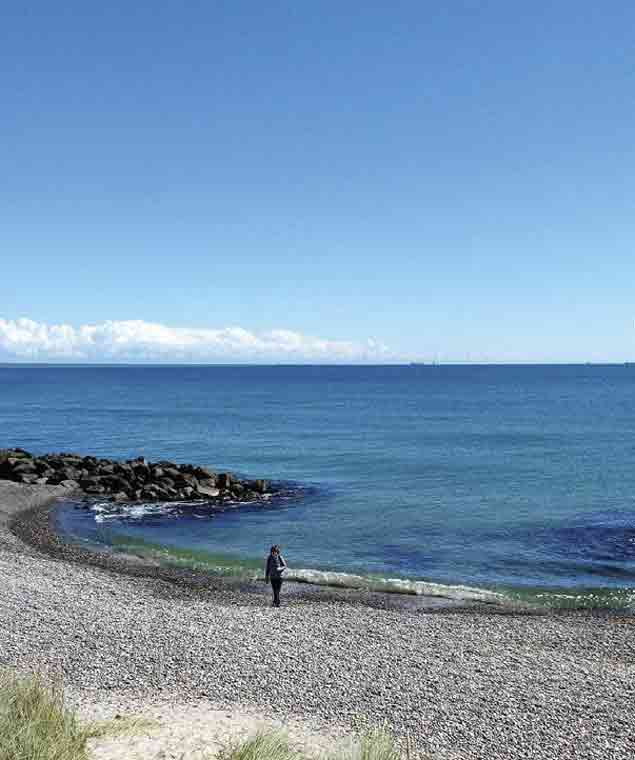 Skagen, where the Skagerrak meets the Kattegat
Skagen, where the Skagerrak meets the Kattegat
Exiting Sweden the southwest wind hardened, we close hauled in an exhilarating 45mile sail across the Kattegat holding the course to Skagen, Denmark. It was a vibrant town with many examples of Danish design and a reputation for art and artists. If the art was current, the artists might be ‘helping police with their enquiries’. we visited art galleries and museums. Over the next few days we hired bikes and cycled out to the lighthouse at Grenen beach where the seas of the Skagerrak and Kattegat skirmish. Conscious of the impending North Sea crossing, we watched weather patterns. Yachts waiting many weeks in Norway to cross, had turned south to seek favourable passage. A miracle, the weather began to shift. The original plan to get to westernmost point of Norway and wait was abandoned.
15th August; 11.30 with the barometer at 1020 we sailed west. The swell faded, a red sunset and rising moon herald a splendid night at sea. In the morning, a light westerly returned, we motored all day and through the cold night, the sea was glassy. Next day, oil fields, we pass steel behemoths sucking the residue of long dead microscopic plants and animals. Their stored energy pushing Pylades over their grave. A whale slid by and a pod of white beaked Dolphins visited. There was a stunning sunset as ‘Turner’ reds to the north blend with muted blues and greys to the south, Then Scotland’s version of ‘Tierra del Fuego’ came to life, the huge fire flares of the rigs, welcomed Pylades. Towards dawn a southeast wind picked and we were sailing, later as the wind touched 30 knots, we passed into the relative shelter of the Moray Firth, the wind increased further, hugging the windward south shore we jogged happily along all night under a scrap of headsail.
19th August; at dawn, we entered the snug marina at Inverness, the warm welcome offsets the slightly shabby town, perhaps we had become used to Nordic habitats. Next day we payed £233.00 and entered the Caledonian Canal, magnificent 200-years-old engineering working perfectly. One of the lock keepers remarked, “I have the nicest job in the fairest surroundings one could get”. They helped with the lines and engaged in great discussions on ‘Brexit’ and much else.
 At Neptune’s Staircase
At Neptune’s Staircase
Lough Ness is long, narrow, deep and it funnels the wind on the nose. By 16.00 we walked Fort Augustus where the battle cries of Culloden still echo. The next day, by Loch Lochy’s shore a golden eagle held position in a westerly breeze and we caught our first sight of Ben Nevis.
23rd August; a busy morning descending Neptune’s Staircase to the fine stone basin at Corpach. To the south, the magnificent bulk of Ben Nevis brought great memories of a day spent on its airy ridges. The following morning, we were at sea rushing south on a fair tide through the Corran Narrows. Oban Marina was almost deserted, we ferried to town and stock up, the water at the marina was not recommended but a kindly occupant of Kerrera Island insisted we take 20 litres of bottled water. 04.00 next morning, with the light not yet in the sky we were underway.
There was a cold Autumnal feel to the air as a light wind freshened from the southeast. In a rollicking sail, Islay faded as Malin Head materialised to the south. Seven miles from the entrance to Lough Swilly the wind veered to the southwest and freshened considerably, squalling to 35 knots. We battered our way to the calmer waters of the lough and in darkness and rain felt our way in to Port Salon, assisted by a howling wind we bedded our anchor at 23.15. The morning was fine but blowing hard from the southwest, a lazy day was passed swinging to our anchor, on odd jobs, plotting our jumps home and topping up the diesel tank from cans.
26th August; 06.00 underway in a light south-easterly, the forecast was sympathetic for only a few days, so with regret we passed Tory Island. Donegal Bay was deserted, except for two Spanish trawlers, who, just north of Eagle Rock appeared intent on running us down. With a poled-out Genoa, we ran south in splendid conditions discussing the magnificent headlands and Islands of our coastline. 19.30 on the 28th August we tied a Kilronan and strolled to Tí Joe Mac, for a contemplative pint. A late breakfast with ‘fry up’ we resolved to do little all day, but slowly walk the beaches and make sandcastles.
Tuesday the 30th August, over canvassed and with mixed feelings we had a fast reach east to Kinvara bay and picked up our mooring at Parkmore. The 3800 mile, 109-day voyage to Russia had concluded. We loaded the dingy, outboard and gear into our van. Ashore, we looked out at Pylades, alone on its mooring and with a tear in our eye, drove slowly home.


























